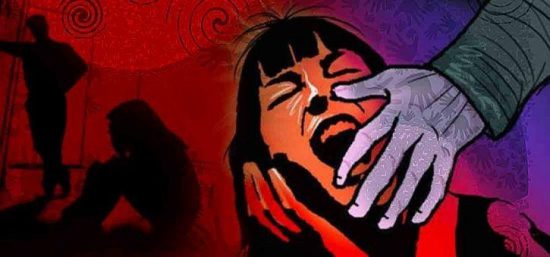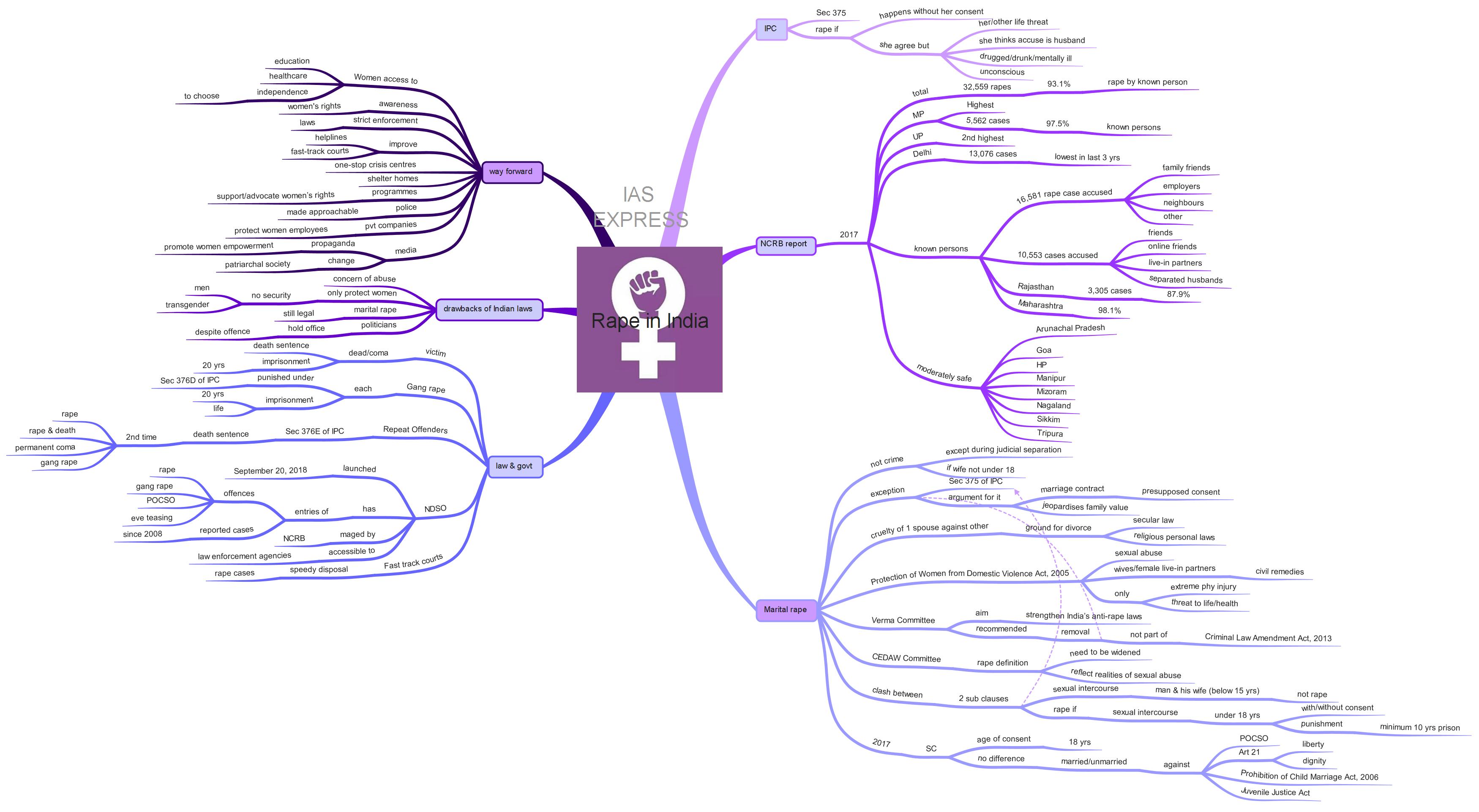Rape Crisis in India – Present Status, Legal Remedies & its Drawbacks

From Current Affairs Notes for UPSC » Editorials & In-depths » This topic
IAS EXPRESS Vs UPSC Prelims 2024: 85+ questions reflected
The gang-rape of a veterinary doctor whose body was set ablaze and dumped under a bridge has sent shockwaves through India, with hundreds of women taking to the street in protest. Less than 24 hours of this incident, another charred body of a 35-year old woman was found in the same area. The gruesome nature of this crime has brought back the chilling memories of the Nirbhaya incident that took place in Delhi in December 2012. People from all walks of life have come together to demand capital punishment for the accused.
What is rape as per the Indian Penal Code?
A “rape” charge under Section 375 of IPC has two parts:
- Non-consensual penetration of any orifice in women by a man, or,
- Non-consensual touching of any orifice with the mouth. This is not restricted to having sex. Forcing a woman to this herself, or with someone else, is also rape.
The court will decide that these acts are rape if:
- It happens without her consent, or
- She agrees, but only because she or someone she knows is in danger, or
- She agrees, but because she thinks the accused person is her husband, or
- She agrees, but she is drugged, or drunk, or mentally ill, or
- She is under 18 – then it does not matter if she agreed or not, or
- She is in no position to indicate whether she agreed or not – for example if she is unconscious.
Consent is defined as a clear, voluntary communication that the woman agrees, leaving no room for debate. It also makes it clear that the absence of physical injuries is immaterial for deciding consent.
What does the latest NCRB report reveal about rape in India?
- The National Crime Records Bureau (NCRB) has released the annual Crime in India Report 2017 on October this year, after a delay of two years.
- A total of 32,559 rapes were reported in 2017.
- Madhya Pradesh has recorded the highest number of rape cases at 5,562 cases being reported in 2017.
- Uttar Pradesh is the second-highest after MP with the number of cases of rape reported during the same year.
- Delhi, on the other hand, saw a decline in reporting of rape cases. In 2017, 13,076 cases were reported, the lowest in the last three years.
- Rape by known persons still holds a large percentage of all the cases reported.
- Out of the 32,559 reported cases, 93.1% of the accused were known to the victims.
- The report highlights that 16,581 rape cases were reported against family friends, employers, neighbours or other known persons and in 10,553 cases, the accused were friends, online friends, live-in partners or separated husbands of the victims.
- Out of the 5,562 cases reported in Madhya Pradesh, 97.5% were committed by known persons.
- In Rajasthan, of the 3,305 cases, 87.9% were also committed by the known persons.
- In Maharashtra, 98.1% of the rape cases were reported against friends, associates or relatives.
- Arunachal Pradesh, Goa, Himachal Pradesh, Manipur, Mizoram, Nagaland, Sikkim and Tripura is seen to be moderately safer than other states as they have the lowest recorded number cases.
Is Marital Rape a crime in India?
- Marital rape is not a crime within India’s legal framework, except during the time of judicial separation of the married couple.
- The marital rape exception under Section 375 of the IPC states that the sexual intercourse by a man with his own wife, the wife not being under 18 years of age, is not rape.
- It was argued by the government that the contract of marriage presupposed the consent and that the criminalisation of marital rape, in turn, would degrade India’s family values.
- Forced sex by husbands upon wives does have legal consequence in India’s matrimonial law, in which it can be treated as a matrimonial fault, resulting in the ending of the marriage contract.
- All religious personal laws and secular law governing marriage and divorce deem “cruelty” by one spouse against the other to be ground for divorce.
- The Protection of Women from Domestic Violence Act, 2005 stated that marital rape is also a “sexual abuse”.
- Under this Act, the aggrieved wives or female live-in partners can claim civil remedies.
- This law focuses on marital rape only in cases when it is accompanied by extreme physical injury or when the health and safety of the wife are in danger.
- The Verma Committee was constituted to strengthen India’s anti-rape laws.
- This committee had strongly recommended that the exception for the marital rape should be removed.
- It had also highlighted the recommendations of the CEDAW Committee pertaining to India in 2007, asking for the “widening of the definition of rape to reflect the realities of sexual abuse experienced by women and to remove the exception of marital rape from the definition of rape”.
- Though most of the recommendations made by the Verma Committee were incorporated, the suggestion to criminalise marital rape is not a part of the Criminal Law Amendment Act, 2013.
- Until 2017, there was a clash between two sub-clauses of Section 375 of IPC.
- Exception 2 stated that “sexual intercourse between a man with his own wife not being under 15 years of age, is not a rape”.
- However, the same provision stated that a man is said to have committed rape if his sexual intercourse is with a women with or without her consent when she is under 18 years of age.
- In 2017, the Supreme Court held that the age of consent as 18 years.
- The apex court had also held that it is illogical to differentiate between a married girl child and an unmarried girl child as it is against the Protection of Children from Sexual Offences Act, 2012.
- It also stated that such a distinction is a violation against a child’s liberty and dignity under Article 21 of the Indian Constitution.
- Prohibition of Child Marriage Act, 2006 and the Juvenile Justice Act also undermines the original IPC section as both of them define a child as someone who is below the age of 18.
- Irrespective of her marital status, sex with a minor girl is a crime that leads to a minimum rigorous imprisonment of 10 years.
- However, until now, the apex court has refrained from making any observation regarding the marital rape of a woman who is above 18 years.
What are the legal provisions of government measures against rape?
Rape and Murder:
- During a rape, if the accused injured the women so badly that she either dies or goes a vegetative state, he can be given death sentence or imprisonment for up to 20 years.
- This provision, however, does not define what “persistent vegetative state” means.
- The SC clarified that a person who is alive but does not show any evidence of being aware of one’s environment is in a permanent vegetative state.
Gang rape:
- If a woman is raped by a group of people at the same time, each of them will be punished under Section 376D of IPC.
- The punishment is imprisonment of between 20 years and life imprisonment.
Repeat Offenders:
- The Section 376E of IPC allows for the death sentence to the person convicted for the second time for rape, rape causing death or result in a permanent vegetative state, or gang rape.
National Database on Sexual Offenders (NDSO):
- The government launched NDSO on September 20, 2018.
- It contains entries of the offenders convicted under the charges of rape, gang rape, POCSO and eve-teasing.
- It contains entries of cases that were reported since 2008.
- It is managed by NCRB.
- It is accessible to only the law enforcement agencies for the investigation and monitoring purposes.
- In response to the 2012 Delhi Gang Rape Case, the Indian government established the fast-track courts for the speedy disposal of the rape cases.
What are the drawbacks of the anti-rape laws in India?
- There is a growing concern over the potential abuse of the anti-rape laws.
- Indian anti-rape laws only protect women from rape and sexual assault. They don’t provide security to men and transgender people.
- These laws are limited and don’t have violence or coercion at their core.
- Marital rape is still legal – unless the married couple is separated.
- The politicians accused of the crime may remain in office and benefit from the slow justice system until convicted.
Way forward?
- Every individual must decide and affirmatively agree that all have the right to be safe.
- Everyone is equal before the law. Therefore, all women and girls must be given access to education, healthcare, and choice of career, choice of a marriage partner or the right to stay single.
- They shouldn’t be chastised for their choice of clothes, friends or leisure activities.
- In short, they should be given respect and be allowed to exercise their rights and their life must not be defined by the social norms.
- Awareness must be made at the grass-root level to both men and women about women’s rights.
- The men in Indian society must be educated so that they understand respect, boundaries and consent in a way that will prevent them from violating women’s rights.
- The government must ensure that the laws are strictly enforced.
- It must improve the infrastructure to protect women’s rights.
- It must also make marital rape illegal.
- Half of the Nirbhaya fund is unutilized despite the desperate need for helplines, fast-track courts, one-stop crisis centres and shelter homes.
- Funding also must be provided for programmes to support and advocate women’s rights.
- The police must play a pro-active role in making the police stations welcoming places for women so that they can file complaints with ease.
- Under-reporting of such crimes does not help in solving this problem.
- Steps must be taken so that it is not tabooed in society.
- Private companies can play a role in protecting their women employees from such heinous crimes.
- Providing cabs for those who are working in night shifts is one of the many measures that can be taken by the private companies in protecting their female employees.
- Representation of women on screen must change.
- The TV shows must cease the culture of objectifying women and ban those contents that may be harmful to women.
- Instead, women on screens must be given strong lead roles. They must be portrayed as the one with equal and independent powers as that of their male counterparts.
- The film industry has far more power in changing society’s mindset than laws.
- They must make sure India’s patriarchal society becomes the one that cherishes equality and coexistence of all.
- Thus, united efforts of people from all walks of life along with active enforcement of laws can bring wonders to the society.
Model Question:
Laws alone cannot address the problem of rape in India. Comment.
If you like this post, please share your feedback in the comments section below so that we will upload more posts like this.


